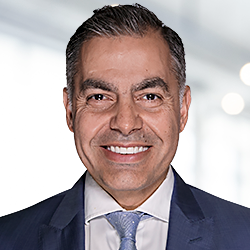Voya Intermediate Fixed Income SMA
Approach
The Voya Intermediate Fixed Income strategy seeks to provide total return while preserving capital largely through the use of treasuries, agencies, and corporate credit securities of 1-10 year maturities.
Investment Philosophy
We believe that intensive security level research paired with a broadly informed awareness of the economic and credit cycle are critical to identifying superior investment opportunities and managing downside risk.
The following key beliefs underpin our investment philosophy:
- Security selection is a significant driver of risk and returns
- Nimble sector and sub-sector allocations capture relative value
- Risk management is critical throughout the entire investment process
These three key beliefs frame an integrated strategy that incorporates a dynamic blend of top-down and bottom-up approaches.
Investment Process
Supported by a seasoned team of fixed income professionals, our three-step process leverages the collective insights from across Voya’s Fixed Income platform, incorporating both top-down and bottom-up research insights. First, the Investment Committee establishes the macro view and assesses the current risk regime. This assessment includes an estimate of "achievable alpha", which in turn influences the team's recommended risk posture. Next, the Multi-Sector Portfolio Management team discusses the investment themes and target risk profile to construct a model portfolio incorporating the strategy's guidelines and objectives. Finally, individual sector teams are then responsible for identifying and trading specific bonds.
Approach
The Voya Intermediate Fixed Income strategy seeks to provide total return while preserving capital largely through the use of treasuries, agencies, and corporate credit securities of 1-10 year maturities.
Investment Philosophy
We believe that intensive security level research paired with a broadly informed awareness of the economic and credit cycle are critical to identifying superior investment opportunities and managing downside risk.
The following key beliefs underpin our investment philosophy:
- Security selection is a significant driver of risk and returns
- Nimble sector and sub-sector allocations capture relative value
- Risk management is critical throughout the entire investment process
These three key beliefs frame an integrated strategy that incorporates a dynamic blend of top-down and bottom-up approaches.
Investment Process
Supported by a seasoned team of fixed income professionals, our three-step process leverages the collective insights from across Voya’s Fixed Income platform, incorporating both top-down and bottom-up research insights. First, the Investment Committee establishes the macro view and assesses the current risk regime. This assessment includes an estimate of "achievable alpha", which in turn influences the team's recommended risk posture. Next, the Multi-Sector Portfolio Management team discusses the investment themes and target risk profile to construct a model portfolio incorporating the strategy's guidelines and objectives. Finally, individual sector teams are then responsible for identifying and trading specific bonds.
Performance
Performance
| As of 11/30/25 | 1 Mo | 3 Mo | YTD | 1Yr | 3Yr | 5Yr | 10Yr | Since Inception (1/01/93) |
|---|---|---|---|---|---|---|---|---|
| Gross | 0.69 | 1.51 | 6.43 | 5.74 | 4.45 | 0.76 | 2.15 | 4.29 |
| Net | 0.57 | 1.14 | 5.00 | 4.19 | 2.91 | -0.78 | 0.37 | 2.88 |
| Index* | 0.67 | 1.53 | 6.87 | 6.21 | 4.96 | 0.98 | 2.24 | 4.32 |
* Bloomberg U.S. Intermediate Government/Credit Index
Past performance does not guarantee future results. Periods greater than one year are annualized. Performance data is considered final unless indicated as preliminary. Monthly performance is based on full GIPS Composite returns. Access the GIPS page for full composite details. "Gross Returns" are presented before the deduction of transaction costs and should be used as Supplemental Information only. "Net Returns" are calculated by subtracting a hypothetical maximum total wrap fee (estimated at 1.50% per annum) from the monthly "pure" gross-of-fee returns. For periods from January 2007 to June 2021 the hypothetical maximum fee was 2.00% per annum. The total wrap fee includes transaction costs, portfolio management, investment advisory, custodial and other administrative costs. Wrap fees vary amongst brokerage firms and may be negotiated based on account size and other factors. The hypothetical maximum total wrap fee used is deemed to be the maximum fee charged to any composite account but we cannot guarantee accuracy. More information about fees can be found in the Form ADV Part II of Voya Investment Management Co.
Literature
Date: September 30, 2025
Approved For: Public Use Material
Date: September 30, 2025
Approved For: Financial Professional Use Only
Investment Team
Disclosures
Principal Risk
The principal risks are generally those attributable to bond investing. Holdings are subject to market, issuer, credit, prepayment, extension, and other risks, and their values may fluctuate. Market risk is the risk that securities may decline in value due to factors affecting the securities markets or particular industries. Issuer risk is the risk that the value of a security may decline for reasons specific to the issuer, such as changes in its financial condition. The strategy may invest in mortgage-related securities, which can be paid off early if the borrowers on the underlying mortgages pay off their mortgages sooner than scheduled. If interest rates are falling, the strategy will be forced to reinvest this money at lower yields. Conversely, if interest rates are rising, the expected principal payments will slow, thereby locking in the coupon rate at below market levels and extending the security’s life and duration while reducing its market value. High yield bonds carry particular market risks and may experience greater volatility in market value than investment grade bonds. Foreign investments could be riskier than U.S. investments because of exchange rate, political, economics, liquidity, and regulatory risks. Additionally, investments in emerging market countries are riskier than other foreign investments because the political and economic systems in emerging market countries are less stable.

